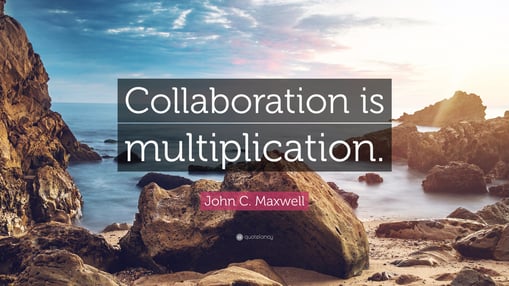Onyeka Ndukwe
With employees spread out across different locations, collaboration between HR and other departments can suffer but don’t let that be your story.
Your organization can still achieve great synergy by using the right tools and processes.
Introduction

The right recipe (or plan) can help a team to achieve more together than as individuals.
Reducing your workload. Sharing new ideas. Creating collaborative job descriptions. By effectively harnessing the power of collaboration, you stand to gain a lot more than you think.
If you are reading this post, then it’s safe to say that you desire a better process for your organization’s job descriptions.
This is not an impossible goal. All it takes is a different mindset towards job descriptions, the right tools and a bit of elbow grease.
This blog post is to help show you how job description collaboration can help with your job description process. In a hurry? Jump straight to your section of interest by clicking on a link (see below).
Article table of contents (jump to a section):
1. What is a Job Description?
2. Teamwork vs Collaboration
3. 3 Benefits of Job Description Collaboration
4. Example of Job Description Collaboration or Collaborative Job Descriptions
5. Conclusion
What is a Job Description?
A job description is a complete record of the required skills and behaviors, responsibilities, education, knowledge areas, and more.
The use of competencies on job descriptions can add tremendous value to your job descriptions and transform it into a living document. This enhanced job description has more relevance and use beyond the typical hiring process.
Increasing the quality of your organization’s job descriptions can also positively impact the quality of your new hires and improve your hiring process (in addition to increasing the fairness of your process).
The job postings that organizations use for recruitment and hiring can be derived from their job descriptions. Think of a job posting as a slice of pie and a job description as the whole pie (the flavor is entirely up to you!)
Teamwork vs Collaboration
Believe it or not, teamwork and collaboration are not the same thing (despite their similarities).
When it comes to teamwork vs collaboration, the key difference between the two terms is the authority structure or power distribution.
With collaboration, power or authority is usually distributed between the parties involved. There is a clear understanding that the project cannot be completed without everyone’s involvement. Those who collaborate have a common objective, have no need for a designated leader (though someone may be tasked to manage the project) and can freely discuss ideas towards their main objective.
Think of collaboration as an activity involving co-leaders working together on a project. By sharing both the authority and burden of a project, individuals who collaborate can put their energies towards its completion due to this unique distribution.
Teamwork, on the other hand, usually has a leader who is the final authority on all decisions and involves more delegation of tasks.
In addition, the organization of a team requires have a detailed plan with clear guidelines and monitoring for all related activities. The success of the project is heavily dependent on the leader’s own abilities (not those of their teammates).
3 Benefits of Job Description Collaboration

- Better Quality Job Descriptions: By bringing together the various (but relevant) strengths of those involved in building job descriptions, you can achieve far more than each person could do individually.
This can mean more introspection on personal strengths and weaknesses when it comes to understanding a job position within a department and how best to portray the job requirements on a job description.
Knowing this can help employees collaborate better to deliver a high quality, updated job description that can be used for hiring and employee development plans.
- Employees Learning from Each Other: Through collaboration on a job description project, those involved will learn more about the work ethic or mindset of their teammates. This helps to get better insights (from the HR perspective) as to the key skills/competencies needed for hiring in a specific industry (theoretical vs practical).
For example, a HR manager can get a better understanding of the exact skills needed for an IT position and use it to refine the content on that job description. This is because they involved the head of the IT department rather than relying on IT job postings floating around on the Internet.
Managers and executives have a vested interest in acquiring the best possible candidate and doing so in a timely manner. When working on collaborative job descriptions, involving these individuals is important as you can draw on their valued expertise and reduce the amount of research time required.
- Increased Efficiency: Job description collaboration can add more pace to the completion of your job description project.
Without collaboration, a HR specialist will have to devote more resources (I.e. time, energy and focus) which might not be readily available due to other HR responsibilities.
For example, imagine creating a job description only to find out (after hiring a candidate) that half of the job responsibilities and qualifications are not applicable to the role. This is because they are 5 years out of date. Someone who currently works in the field you are hiring would be best equipped to notice this and recommend up-to-date job responsibilities and qualifications.
With the right job knowledge from collaborators, a HR specialist can better utilize their precious time and cut short the amount of time needed for research. This can help them create or update job descriptions in a few days whereas it might have taken 3 weeks without collaboration.
Want to improve your job description process?
Fill out the form below to access our Job Description Toolkit today!
Example of Job Description Collaboration or Collaborative Job Descriptions
Jane, a new HR specialist at Acme Company, is tasked with creating job descriptions of a new branch of the company.
Her focus is to help the company fill 300 new Customer Service Representative positions.
Digging into Acme’s database, she discovers that the job description files are seriously out-of-date. Some of the physical documents even mention the importance of being fast on a typewriter (Acme might be an old company but not that old).
As she types “best job description for customer service representative” on Google, Jane suddenly pauses and decides to call Tara, Head of Sales at their New York branch.
During the call, Tara mentioned that she had to significantly modify the job descriptions at her branch because Acme’s own files are not up-to-date with the industry standards.
She also mentions that the job description templates on Google were nice but didn’t help much since they needed much reviewing to make sure they mirrored Acme’s standards.
Tara offers to send Jane a job description template to use and gives a few recommendations of emerging skills might be needed for the new hires.
Once the call is finished, Jane hangs up the phone and lets out a relieved sigh. She reviews the job description template, makes a few edits then sends it back to Tara for review. This leaves her with more time to work on other HR tasks and priorities.
The following day, Jane has the completed job description ready to present to her boss and is confident in its quality.
We’ve talked a lot about processes to help with job description collaboration but what about the tools to achieve this?
In the video below, you can see how the right job description software can simplify the process for creating and using collaborative job descriptions.
Conclusion
When building a quality job description, collaboration can go beyond the HR department and reach those professionals who know the job best.
Are you confident in the quality of your company’s job descriptions? Would you be proud to showcase your job descriptions to another HR professional?
If you are even a little bit unsure, it might be worth it to create collaborative job descriptions by working with the right person in your organization.
It could save you time, stress and help deliver the best job descriptions possible for your next hire.
Post updated: March 24, 2020.

Submit a Comment